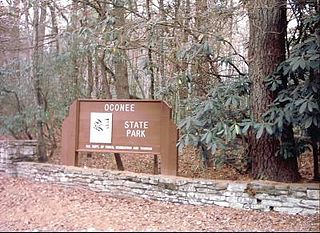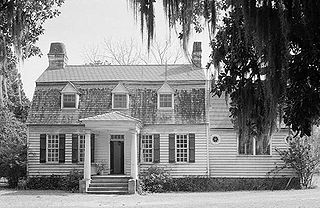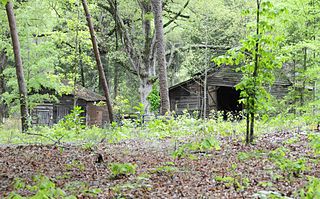
Walhalla is a city in the foothills of the Blue Ridge Mountains in Oconee County, South Carolina, United States. Designated in 1868 as the county seat, it lies within the area of the Blue Ridge Escarpment, an area of transition between mountains and piedmont, and contains numerous waterfalls. It is located 16 miles (26 km) from Clemson University in Clemson, South Carolina.

Oconee State Park is a state park located in the Blue Ridge Mountain region of South Carolina. This 1165-acre (472 ha) park has several recreational opportunities to choose from. They include cabins, camping, fishing and boating in the two small lakes located on the park grounds, hiking on eight nature/hiking trails, and several picnic and meeting facilities.

The King-Hooton House is a historic home in Pensacola, Florida. It is located at 512–514 North Seventh Avenue. On August 23, 1991, it was added to the U.S. National Register of Historic Places.

The Francis Marion Stokes Fourplex is a historic residential building located in the Northwest district of Portland, Oregon, United States.

Oconee Station was established in 1792 as a blockhouse on the South Carolina frontier. Troops were removed in 1799. The site also encompasses the Williams Richards House, which was built in the early 19th century as a residence and trading post. The site is listed on the National Register of Historic Places in 1971 as Oconee Station and Richards House.

The Lancaster County Jail is a historic former jail building at 208 West Gay Street. Built in 1823, it is a virtually unaltered work of the noted early American architect Robert Mills, and reflects innovative changes in jail design promoted by him. It is individually listed on the National Register of Historic Places, and was declared a National Historic Landmark in 1973.

Benjamin Church House is a Colonial Revival house at 1014 Hope Street in Bristol, Rhode Island, U.S.A. It opened in 1909 as the "Benjamin Church Home for Aged Men" as stipulated by Benjamin Church's will. Beginning in 1934, during the Great Depression, it admitted women. The house was closed in 1968 and became a National Register of Historic Places listing in 1971. The non-profit Benjamin Church Senior Center was incorporated in June 1972 and opened on September 1, 1972. It continues to operate as a senior center.

The Walhalla Graded School, built in 1901, is an historic building located at 101 E. North Broad Street in Walhalla, South Carolina. It was designed by noted Columbia architect William Augustus Edwards of the firm of Edwards and Walter and built by Grandy & Jordan of Greenville.

The Oakland Plantation House which is also known as Youghall or Youghal Plantation House, was built about 1750 in Charleston County, South Carolina about 7 mi (11 km) east of Mount Pleasant. It is located about 1 mile (1.6 km) south of U.S. Route 17 on Stratton Place. It was named to the National Register of Historic Places on July 13, 1977.

The building at 426 South Main Street is located in Canandaigua, New York, United States. It is a two-story brick dwelling in the Italianate architectural style built around 1880. In 1984 it and its neighboring barn were listed on the National Register of Historic Places.

The Oconee County Cage is a former jail on wheels that is located at Browns Square Drive outside of the Oconee Heritage Center in Walhalla, South Carolina, USA in Oconee County. At the time of its listing, it was located on Church Street at the Oconee County Law Enforcement Center. It was named to the National Register of Historic Places on November 14, 1982 along with the Oconee County Jail. At the time of its listing, the cage was considered the most intact cage in South Carolina. Oconee County has preserved the cage as a reminder of the former harsh conditions faced by convicts in the early twentieth century.

The Long Creek Academy is a former Christian school that is located at the intersection of Academy Road and South Carolina S-37-339 near U.S. Route 76 near Long Creek, South Carolina in Oconee County. It was named to the National Register of Historic Places on November 20, 1987. It is currently used by a whitewater rafting company.

The Dr. Abram Jordan House is located along the NY 23 state highway in Claverack-Red Mills, New York, United States. It is a brick Federal style house, with some Greek Revival decorative touches, built in the 1820s as a wedding present from a local landowner to his daughter and son-in-law.

City Market is a historic building located in downtown Davenport, Iowa, United States. It was individually listed on the National Register of Historic Places in 1984. In 2020 it was included as a contributing property in the Davenport Downtown Commercial Historic District.

The Louis P. and Clara K. Best Residence and Auto House, also known as Grandview Apartments and The Alamo, is a historic building located in the central part of Davenport, Iowa, United States. It was included as a contributing property in the Hamburg Historic District in 1983, and it was individually listed on the National Register of Historic Places in 2010.

The Jonesborough Historic District is a historic district in Jonesborough, Tennessee, that was listed on the National Register of Historic Places as Jonesboro Historic District in 1969.

The Keil Farm is a property listed on the National Register of Historic Places, located near South Carolina Highway 11 in the vicinity of Walhalla, South Carolina, in Oconee County. The property includes a c. 1850 farm house and six contributing outbuildings. The farm, built by John Henry Keil, Sr. is seen as an important symbol of the role German immigrant families played in the development of the area.

Old Colleton County Jail is a historic library building located at Walterboro, Colleton County, South Carolina. It was built in 1856, and is a stuccoed brick building in the Gothic Revival style. The building was designed by noted Charleston architects, Edward C. Jones and Francis D. Lee. The jail in part resembles a miniature, fortified castle. The front façade has crenellated parapets, turret-like structures at either corner, and a massive central tower with a large lancet window above the main entrance.

The first Kosciusko County Jail was built in 1837 of 14 inches (36 cm) square logs. It was two stories tall with a trap door from the second story floor to access the ground floor. The next jail was made of brick. Like the first jail, it was located on Courthouse Square. By 1869 this second structure was in serious need of repair. Frequent jail breaks from the second jail, led the county to hire George Garnsey of Chicago to design a new jail. The most notable jailbreak resulted when prisoners pushed bricks out of the wall.






















